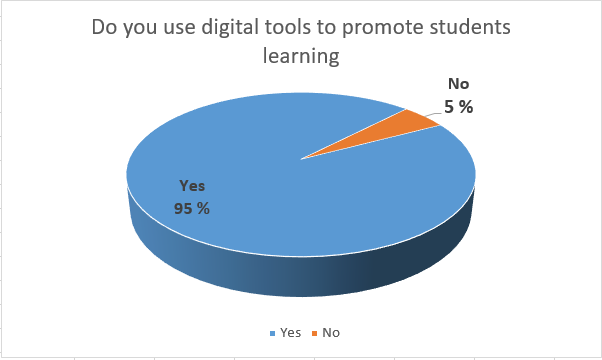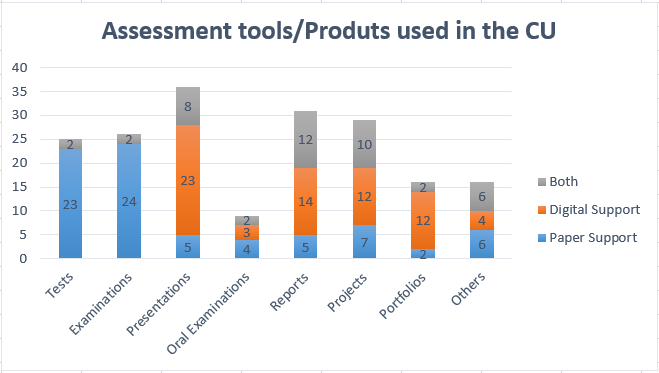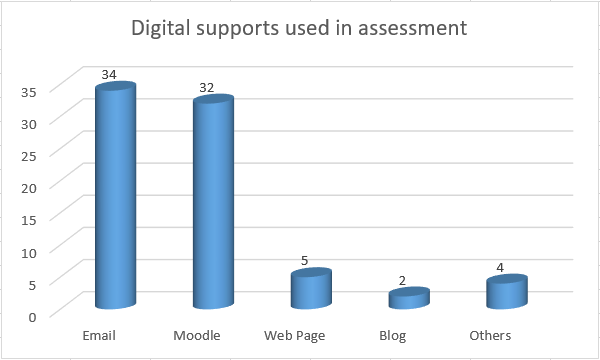
Ana Luisa de Oliveira Pires & Maria do Rosário Rodrigues
In recent years, the use of ePortfolios in Higher Education has increased worldwide, going along with the ongoing educational reforms. In parallel, the visibility of ePortfolios has increased as an object of research in the field of education. This article discusses some of the challenges and possibilities related to the use of ePortfolios in Higher Education, from the academic’s perspective. It focuses on an exploratory study conducted in a Portuguese public higher education institution, the School of Education of Polytechnic Institute of Setubal (ESE-IPS). The purpose of the study was to understand the academics’ perspective on the use of ePortfolios to assess challenges and possibilities of their future implementation.
This study was developed under the Empowering ePortfolio Process project, an Erasmus+ KA2 project aimed to develop student-centred education. The EEP project is coordinated by Häme University of Applied Sciences (HAMK, Finland) in partnership with five European Higher Education institutions: VIA University College (Denmark), KU Leuven (Belgium), UC Leuven-Limburg (Belgium), Polytechnic Institute of Setúbal (Portugal) and Marino Institute of Education (Ireland). The project took place between September 2016 and November 2018.
The EEP focus is “on assessment and guidance practices, and by developing an empowering and dynamic approach to the e-portfolio process” (Kunnari & Laurikainen 2017, 6). Its purpose was to promote the academic success of students by raising their motivation and responsibility regarding both their academic path and their future professional life. The purpose is to contribute to fostering their employability, active citizenship and social participation in the digital world.
Under the EEP project, the partner institutions have been developing pilot activities with the finality to investigate and develop the engaging and empowering ePortfolio process from different perspectives. Thus, the Portuguese research team has been developing a pilot study in order to implement motivating ePortfolio practices, which can actively mobilise students and academics and contribute to improving pedagogical strategies and the educational environment of the organisation.
This ePortfolio project adopts the concept of “student-owned digital working and learning spaces for collecting, creating, sharing, collaborating, reflecting learning and competences, as well as storing assessment and evaluation. They are platforms for students to follow and be engaged for their personal career development, and actively interact with learning communities and different stakeholders of the learning process.” (Kunnari & Laurikainen 2017, 7).
Background
In the past decade, we have witnessed increasing interest in processes of ePortfolios used in Higher Education in a generalised way, from both the initiative of higher education institutions and programmes funded by governments, which has led to the development of research and the deepening of knowledge in this field. These projects are helping to improve the processes of teaching and learning by changing the practices of academics, students, and institutions (Rowley & Munday 2018).
We are aware that ePortfolio practices have proved beneficial from the students’ perspective, resulting in more involvement in their learning process, more motivation and commitment, an increase in their autonomy and reflexivity, among multiple skills in their academic and professional life (Barrett 2007; Beckers, Dolmans & Dolmans van Merriënboer 2016; Kunnari, Laurikainen, Pires, & Rodrigues 2017; Rodrigues & Pires 2017; Pires & Rodrigues 2018).
However, despite the growing recognition of ePortfolio contributions in Higher Education, its use is not yet prevailing, since its implementation is dependent on the perception of institutions and academics, as shown by Cho & Brown (2007). Papert (2001) considers educational institutions as complex systems that prevail despite “external aggressions”. This apparent resilience ability is also revealed in its resistance to change. According to the same author, schools have been resisting most reforms, shaping them according to their own dynamics: “The reform tries to change the School but School changes the reform” (ibid., 62). Something similar is happening with the use of educational technologies. Technology is often used to maintain old procedures with new instruments (Prensky 2005). In fact, we also agree that the use of digital tools to build portfolios like those in paper form are more portable and less expensive, but they waste the advantage of communication and collaborative and cooperative work that the technological tools may provide.
Methodology
The approach of this study is mainly qualitative (Bogdan & Biklen 1994; Amado 2014). Data were collected using two types of methods: an on-line survey and interviews with teachers. The purpose is to get knowledge of the educational practices of the academic community, in particular with regards to the teaching and assessment strategies based on digital formats. Thus, we aimed to identify the practices used in the institution, on the one hand, and to understand the academics’ perception about its use (reasons, obstacles/difficulties), on the other. Therefore, we prepared an on-line survey to collect information about the use of strategies and tools for promoting teaching and assessment of students, including portfolios, whether in digital format or not.
The collected data were analysed using qualitative content analysis with categories set a priori. The questions on the basis of the research were formulated as follows:
- To what extent has the ePortfolio been used as a learning and assessment tool by teachers?
- What are the main constraints / barriers to its use?
The first round of the on-line survey was launched in December 2016 and the second round in January 2017. The survey was applied to all 102 academics of the institution. Forty academics replied, which represented a 39.2 per cent answer rate. From the on-line survey results, we selected a group of academics who had stated they used portfolios as a teaching and/or assessment strategy. We interviewed these academics individually to further understand their motivations, obstacles and difficulties. We interviewed 13 academics at the beginning of 2018.
Teaching and assessment strategies used by academics
As mentioned above, all academics on duty in ESE-IPS at the end of the 1st semester of the academic year 2016/17 were surveyed and the amount of respondents was less than a half. The on-line survey was made with Google Forms and it was composed of open-ended and closed questions, with single and multiple choice answers.
Regarding the teaching strategies, the majority of respondents (95 %) said they use digital tools to promote the students’ learning (figure 1).

As for the type of the digital tools used, 38 academics (95 % of the total of respondents) used Moodle, Email, WeTransfer, Facebook groups, Office applications, Internet resources (videos, pages, books, data bases, applets), Blogs and Forms. The main reasons for two academics (5 % of the respondents) reporting not using them are: “They do not fit the CU (Curricular Unit)” and their “lack of digital competences”.
When asked about the type of assessment tools they use (figure 2), academics point to the following as the most important: presentations (36), reports (31), projects (29), exams (26), tests (25), portfolios (16) and others (16). We can see that paper-based exams (24) and paper-based tests (23) are still widely used. The use of portfolios in digital format is reported by twelve academics, with two saying they use mixed formats and two stating they use paper.

As for the type of digital tools used in assessment, email is the most commonly used (34), followed by Moodle (32), webpages (5) and other not specified (4). The use of blogs is referred only by two respondents (figure 3).

These are the reasons why academics use digital assessment tools/ products (referred by 30 respondents) (table 1).
Table 1. Reasons why respondents use digital assessment strategies.
| Practical / organisational aspects | "Ease of access" "Provision and archiving of information" "Speed" "Efficiency" "Versatility" "More practical" "Convenience" "Information registration and organisation" "Accessibility across multiple platforms and everywhere" |
| Pedagogical aspects | "Suitability of CU objectives and contents" "Awakens more interest in students" "Facilitates learning and assessment" "Makes it easy to correct" "Facilitates communication and sharing" "Continuous monitoring of creation and research processes" "Shared by CU Teachers" "Creation of learning communities" |
| Environmental aspects | "Sustainability – Economic and environmental" "Costs & ecological concerns (less waste of paper)" |
On the other hand, the reasons presented by the respondents for not using digital assessment tools/ products (10 teachers) are different and they were explained as follows (table 2).
Table 2. Reasons why respondents do not use digital assessment strategies.
| Pedagogical aspects | "The nature of CU and contents" "Do not fit the evaluation model" |
| Practical aspects | "Need to keep the works longer" "Printed works have other quality (e.g. photos)" "Enjoy writing / correcting with the pen" |
| Deficit of competences | "Difficulty in using available tools" |
| Personal resistance | "Did not feel the need" "It's hard to be too long in front of a screen" "Lack of commitment and will" |
At the end of the survey, the respondents were asked the following question: “If you are not using digital tools in your pedagogical practices, would you like to use them in the near future?”. There were six positive answers. These are the reasons for their interest: “Because they are useful and facilitate the access to certain topics”, “It seems to me it’s time to use them. The students also use them in their mobile phones”, “Because, in the 21st century, I consider it important to use digital tools as pedagogical strategies”, “I use them, but there is a limitation to using them more often” and “I would like to deepen my knowledge in this domain, particularly about the use of digital portfolios”.
After analysing the results of the online survey, we selected a group of respondents that mentioned using portfolios (in general) as a teaching and assessment strategy. We conducted interviews (in person and by phone) to understand how those respondents use these strategies and which are their main difficulties. The analysis of the results showed that most respondents who said they use digital portfolios use them as a learning file, that is, a collection of products developed under the curriculum subjects they teach. Most of these curriculum subjects are related to the initiation of professional practice. These are individual portfolios, in general composed of texts in digital format. Nevertheless, they do not include intermediate feedback.
However, some respondents value the portfolio from a dynamic perspective, seeing it as a process. They value the continuous, collaborative and evolving nature of this type of learning, emphasising the feedback and the interaction between peers. The majority of respondents use portfolios in an isolated way in the curricular subjects they teach, stating that this is not a team/group practice.
The respondents who only use portfolios in paper, point out some barriers to its use in digital format, in relation to different factors: lack of digital competences, lack of pedagogical training, resistance to change, inertia, routine or accommodation to traditional practices, lack of a shared digital culture within their pedagogical team, lack of conditions to promote reflective portfolios due to time constraints and few available resources.
Challenges and possibilities
By analysing the information above, we can see that although a minority of academics uses ePortfolios in their educational practices, the majority already uses learning and assessment strategies based on digital tools. In general, academics mobilise a diversified range of digital tools. This shows the dominance of basic skills of communication and information technology. However, we identified some obstacles or barriers related to the use of ePorfolios and personal aspects (resistance to change, inertia, and accommodation) and the lack of digital skills of some respondents. These difficulties in using ePortfolios match the type of obstacles mentioned in previous studies: “(…) were the lack of digital confidence of students (and teachers) and technical constraints of the platforms as well as the digital support from the guiding teachers, the educational programs and the whole institute, which makes the use of ePortfolios unstructured and not reaching its full potential” (Kunnari et al. 2017).
We found that respondents who use ePortfolios do it individually in specific curricular units; the process is triggered by the initiative and responsibility of academics, not being shared within teams nor embedded in the curriculum. On the other hand, most respondents who use ePortfolios see them as a collection of individual and fragmented products leading to a final result, subject to evaluation. These practices are not so much a student-centred learning process nor value the reflective, integrative, dynamic and shared dimension of ePortfolios processes, as argued by the authors in previous studies (Pires & Rodrigues 2018; Rodrigues & Pires 2017).
It is our understanding that a strategy of mobilisation of academics will be strengthen within an organisational project which supports and gives visibility to these practices, combined with a training approach integrating organisational and professional development. On the other hand, integrating these practices in the curriculum would give institutional visibility to ePortfolios and allow a more efficient share of principles and purposes among academics and students. These are aspects that should be considered in the near future.
Luera, Brunvand and Marra (2016) have identified a set of conditions that facilitate the implementation of ePortfolios strategies in Higher Education institutions. Guided by a bottom-up approach, which was considered more sustainable, the authors highlight the following aspects:
- Start with a small group of academics dedicated to the project, holders of “critical mass”;
- Identify shared values and purposes when using ePortfolios; provide a common language to academics and students, as well as a frame to assess the impact of the project;
- Give visibility to the work carried out with the ePortfolio in external or internal events with academics and students; share the practices within a community;
- Diversify the resources for academics and students; promote the development of technological skills necessary to create ePortfolios;
- Ensure flexibility, recognising that the ePortfolio is a tool, which should not depend on just a system or software.
Conclusion
Within this exploratory study, we sought to identify the learning and assessment strategies used by the academics of a higher education institution, focusing in particular on the use of ePortfolios. We noted that although the majority of academics of this institution use pedagogical strategies based on digital formats, and that some academics use ePortfolios, there is still a long way to go to benefit from its potential. Even though a minority of the academics reports the lack of digital skills as one difficulty. The academics also recognise that resistance to change is one of the factors that works as an obstacle to its implementation. Therefore, to support academics in the implementation process of new educational strategies, in particular of a digital nature, Surrey & Land (in Luerra, Brunvand, & Marra 2016) have identified fundamental institutional aspects necessary to promote the desired change. Such aspects are appropriate training, financial support, access to relevant technologies, and openness to accept difficulties throughout the process.
We acknowledge that, to address this complex issue, one should use a broader pedagogical approach, framed at a professional and organizational level, reinforcing the need to go from an individual learning culture to a community learning culture (Senge 1990) or to a community of practices (Lave & Wenger 1991). To such an end, it will be necessary to construct a common framework of reference, share objectives and strategies, work collaboratively inside a collective project that gives meaning to teaching practices. As António Nóvoa (1992) says, any project of change has to be related to personal development (make teachers’ lives), professional development (make the teaching profession), and organisational development (make the school).

This article was produced in the Erasmus+ (KA2 action) funded project “Empowering Eportfolio Process (EEP)”. The beneficiary in the project is Häme University of Applied Sciences (FI) and the partners are VIA University College (DK), Katholieke Universiteit KU Leuven (BE), University College Leuven-Limburg (BE), Polytechnic Institute of Setúbal (PT) and Marino Institute of Education (IE). The project was implementated during 1.9.2016–30.11.2018.
Authors

Ana Luisa de Oliveira Pires has a Ph.D. in Education. She is a teacher at the Department of Social Sciences and Pedagogy at School of Education, and researcher at UIED, New University of Lisbon. Her main area of research is Adult Learning, Lifelong learning policies, Recognition of Prior Experiential Learning, Higher Education, and Teacher Training and Development.

Maria do Rosário Rodrigues has a Ph.D. in Multimedia in Education. She is a teacher at the Sciences and Technologies Department of the School of Education. Her professional activity focuses on the integration of ICT in the curriculum, initial and teachers’ professional development and the design, development and evaluation of digital learning resources.
Bibliography
Amado, J. (2014). Manual de Investigação Qualitativa em Educação. Coimbra: Imprensa da Universidade de Coimbra.
Barrett, H. C. (2007). Researching Electronic Portfolios and Learner Engagement: The REFLECT Initiative. Journal of Adolescent & Adult Literacy, 50(6), 436–449. Retrieved 20 June 2018 from https://doi.org/10.1598/JAAL.50.6.2
Beckers, J., Dolmans, D., & Dolmans van Merriënboer, J. (2016). e-Portfolios enhancing students’ self-directed learning: A systematic review of influencing factors. Australasian Journal of Educational Technology, 32(2), 32–46. Retrieved 20 June 2018 from https://doi.org/10.14742/ajet.2528
Bogdan, R. & Biklen, S. (1994). Investigação qualitativa em Educação: uma introdução à teoria e aos métodos. Porto: Porto Editora.
Cho, Y. & Brown, G. (2007). Exploring Faculty Perceptions of ePortfolio Use and Its Relationship to Faculty Teaching Beliefs. Inter/National Coalition for Electronic Portfolio Research: Final Report from Washington State University, (July), 1–9. Retrieved 14 June 2018 from http://incepr.org/finalreports/WSUfinalreport.pdf
Kunnari, I., Laurikainen, M., Pires, A. O., & Rodrigues, M. R. (2017). Supporting students’ ePortfolio process in Higher Education. In I. Kunnari & M. Laurikainen (eds.) Students’ perspectives in ePortfolios. HAMK Unlimited Journal 12.12.2017. Retrieved 24 June 2018 from https://unlimited.hamk.fi/ammatillinen-osaaminen-ja-opetus/supporting-students-eportfolio-process-in-higher-education
Lave, J. Wenger, E. (1991). Situated Learning. Legitimate peripheral participation. Cambridge, New York: Cambridge University Press.
Luera, G., Brunvand, S., & Marra, T. (2016). Challenges and Rewards of Implementing ePortfolios Through a Bottom-Up Approach. International Journal of EPortfolio, 6(2), 127–137. Retrieved 25 June 2018 from http://www.theijep.com
Nóvoa, A. (1992). Formação de professores e formação docente. In A. Nóvoa (Ed.) Os professores e a sua formação. Lisboa: Dom Quixote, 13–33. Retrieved 20 June 2018 from http://repositorio.ul.pt/handle/10451/4758
Papert, S. (2001). Change and resistance to change in education. In Novo conhecimento nova aprendizagem. Lisboa: Fundação Calouste Gulbenkian, 61–70.
Pires, A. & Rodrigues, M. R. (2018). Empowering students in Higher Education. Perspectives on ePorfolios contributions. European Association for Practitioner Research on Improving Learning 2017 Proceedings, Issue 4, 122–133. March. Ed. EAPRIL.
Prensky, M. (2005). Adopt and Adapt: 21st century schools need 21st century technology. Edutopia. Retrieved 19 June 2018 from http://www.edutopia.org/adopt-and-adapt
Rodrigues, M.R., Pires, A., & Pessoa, A. (2017). Higher education students’ perspectives on the use of ePortfolios. An exploratory study in the context of the Degree in Basic Education. XIX International Symposium on Computers in Education (SIIE), Lisbon, Portugal, 2017.
Rowley, J. & Munday, J. (2018) The evolved landscape of ePortfolios: current values and purposes of academic teachers and curriculum designers. Journal of Teaching and Learning for Graduate Employability, 9(1), 3–22.





